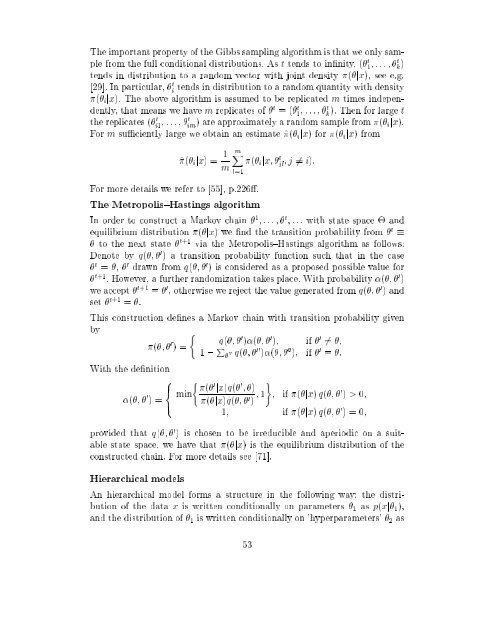Estimation in Financial Models - RiskLab
Estimation in Financial Models - RiskLab
Estimation in Financial Models - RiskLab
You also want an ePaper? Increase the reach of your titles
YUMPU automatically turns print PDFs into web optimized ePapers that Google loves.
The important property of the Gibbs sampl<strong>in</strong>g algorithm is that we only sample<br />
from the full conditional distributions. As t tends to <strong>in</strong>nity, ( t 1;:::; t k)<br />
tends <strong>in</strong> distribution to a random vector with jo<strong>in</strong>t density (jx), see e.g.<br />
[29]. In particular, t i tends <strong>in</strong> distribution to a random quantity with density<br />
( i jx). The above algorithm is assumed to be replicated m times <strong>in</strong>dependently,<br />
that means we have m replicates of t =( t 1;:::; t k). Then for large t<br />
the replicates ( t i1;:::; t im) are approximately a random sample from ( i jx).<br />
For m suciently large we obta<strong>in</strong> an estimate ^( i jx) for ( i jx) from<br />
^( i jx) = 1 m<br />
mX<br />
l=1<br />
For more details we refer to [55], p.226.<br />
The Metropolis{Hast<strong>in</strong>gs algorithm<br />
( i jx; t jl;j 6= i):<br />
In order to construct a Markov cha<strong>in</strong> 1 ;:::; t ;::: with state space and<br />
equilibrium distribution (jx) we nd the transition probability from t <br />
to the next state t+1 via the Metropolis{Hast<strong>in</strong>gs algorithm as follows:<br />
Denote by q(; 0 ) a transition probability function such that <strong>in</strong> the case<br />
t = , 0 drawn from q(; 0 ) is considered as a proposed possible value for<br />
t+1 .However, a further randomization takes place. With probability (; 0 )<br />
we accept t+1 = 0 , otherwise we reject the value generated from q(; 0 ) and<br />
set t+1 = .<br />
This construction denes a Markov cha<strong>in</strong> with transition probability given<br />
by<br />
(<br />
(; 0 q(; <br />
)=<br />
0 )(; 0 ); if 0 6= ;<br />
1 , P 00 q(; 00 )(; 00 ); if 0 = :<br />
With the denition<br />
(; 0 )=<br />
8<br />
><<br />
>:<br />
( )<br />
( 0 jx)q( 0 ;)<br />
m<strong>in</strong><br />
(jx)q(; 0 ) ; 1 ; if (jx) q(; 0 ) > 0;<br />
1; if (jx) q(; 0 )=0;<br />
provided that q(; 0 ) is chosen to be irreducible and aperiodic on a suitable<br />
state space, we have that (jx) is the equilibrium distribution of the<br />
constructed cha<strong>in</strong>. For more details see [71].<br />
Hierarchical models<br />
An hierarchical model forms a structure <strong>in</strong> the follow<strong>in</strong>g way: the distribution<br />
of the data x is written conditionally on parameters 1 as p(xj 1 ),<br />
and the distribution of 1 is written conditionally on 'hyperparameters' 2 as<br />
53
















